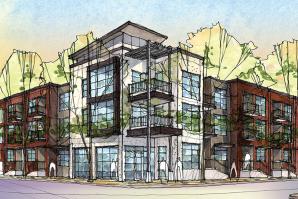The number of distressed properties on the market in the Capital Region is finally shrinking. And, the so-called shadow inventory — properties that are not yet on the market but which are seriously delinquent, in the foreclosure process or foreclosed — is also declining.
Barring another recessionary aftershock, like another big spike in job losses, some market analysts suggest the dust of the housing collapse is settling. A relative sense of normalcy might be returning to the marketplace with fewer homes falling into foreclosure, housing prices increasing, new construction beginning and bidding wars getting fierce.
CoreLogic, an analytics company providing residential property valuations for the mortgage industry, reported in June that residential shadow inventory nationwide has dropped 14.8 percent from a year prior, leaving just a four-month supply on top of what’s already on the market. Last year, the shadow inventory stood at 1.8 million units, a six-month supply — approximately the same level experienced nationally in October 2008.
Since peaking at 2.1 million units in January 2010, the shadow inventory has fallen by 28 percent, says Mark Fleming, chief economist for CoreLogic.
“The decline in the shadow inventory is a positive development because it removes some of the downward pressure on house prices,” Fleming says. “This is one of the reasons why some markets that were formerly identified as deeply distressed, like Arizona, California and Nevada, are now experiencing price increases.”
Doug Duncan, vice president and chief economist with Fannie Mae, says California’s foreclosure inventory has declined since about 2009, while most of the rest of the U.S. essentially has been flat during that period. That doesn’t mean California is out of the woods, he says.
Duncan says the state has “evolved to a series of different kinds of markets. Some areas of the state have significant inventory gluts, where we’ll see some additional price responses. Other areas, like some parts of San Diego and San Francisco, never actually saw a price decline because they remained in high demand despite the national recession.”
Among the hardest-hit areas were Sacramento, Stockton and the Inland Empire, places Duncan thinks are “still a ways off from full recovery.”
Data from RealtyTrac shows an inventory of 87,024 bank-owned properties for sale in California as of May. It would take about nine months to sell all those homes if no others came onto the market.
Meanwhile, Kris Vogt of Coldwell Banker Residential Brokerage in Sacramento says real estate investors can be credited for much of the shadow inventory’s decline nationwide. Investors have been watching home values drop by as much as 60 percent to 70 percent in markets such as the Central Valley, and they’re swooping in to buy and resell, he says.
“I think we started to see some of that money come in a couple of years ago, and the momentum has carried itself,” Vogt says. “What would have otherwise remained on the market in some shape or form is being gobbled up by large pools of money.”
That, in turn, prompted the general public to jump in as well.
“Demand has increased as more buyers are entering the market,” says Greg Gross, a director at Roseville-based research firm Metrostudy. “It’s a good sign that, even with a weak job market, demand remains fairly high in Sacramento.”
Total inventory in the Sacramento area is down nearly 40 percent over a year prior, says Jed Kolko, chief economist and head of analytics at real estate aggregator Trulia.
“Sacramento has gone through more of the foreclosure pain than many other places have,” he says. “Because so many of the foreclosed homes in the region have already been through the foreclosure process, the remaining shadow inventory in Sacramento is now smaller than in many other large metros.”
Kolko explains that the foreclosure process in California moves quicker than states with a “judicial” foreclosure process, such as Florida. In judicial foreclosure states lenders must provide evidence to the courts of delinquency in order to move a borrower into foreclosure, while in nonjudicial foreclosure states, including California, lenders can issue notices of default directly to the borrower without court intervention.
The average base price of new homes has increased 14.3 percent over the past year and, as of the end of the first quarter of this year, stands at $333,500.
As a rule, Kolko says, judicial states have longer foreclosure timelines, affecting foreclosure statistics. Plus, their shadow inventory remains high.
With its falling inventories, increased sales and slightly improving prices, Stockton is behaving similarly to Sacramento, Gross says. In fact, “the Stockton area is actually doing better due to the fact the Bay Area market is so undersupplied with homes,” he says. “Commuters are heading back toward Mountain House, Tracy, Lathrop and Stockton for more affordable homes.”
Short of another economic pratfall, experts generally expect the market to remain on an upswing. That, for one thing, will translate into increased competition among buyers. For example, when Kristi and Fred Garrett placed their Sacramento County home on the market last June, the winning bid came in by noon on the first day it was listed. A steady stream of hopeful buyers continued touring the home in the days that followed.
“By the end of the weekend, we had been presented with about five bids — only one lower than asking price and three at the same as the winning bid. There was one at asking price. The winning buyer had been outbid several times on short sales,” Kristi Garrett says.
People are sensing the bottom of the market from a pricing perspective, says Adam Hieb, vice president of sales and marketing for Shea Homes in Northern California, and historically low interest rates are compounding the urgency to buy.
In the area including El Dorado, Placer, Sacramento and Yolo counties, the average sales price for a single-family home is up 4 percent from May 2011, reports TrendGraphix, which specializes in online market reporting systems for real estate brokers, agents and associations. At the same time, the number of listings or for sale homes has dropped to only 3,369, the lowest level since December 2004. These figures suggest a supply of only about 1.4 months.
Gross says the shrinking housing supply is encouraging some builders to slowly begin constructing new homes, as “there is virtually no standing inventory of newly constructed homes in most areas of Northern California.”
Brent Anderson, vice president of investor relations for Meritage Homes Corp., says permit activity has increased in nearly all of that firm’s Capital Region markets, and in several locations it’s more than doubled since March 2011.
As for standing inventory, Gross says his company has counted only 421 finished and vacant, newly constructed, single-family homes in the six-county Sacramento region.
“At current sales pace, this is only three months of supply,” he says. “This isn’t an alarming number; the majority of these 421 homes are actually sold and weren’t occupied by the time my researchers inspected the home.”
Gross says that the average base price of new homes has increased 14.3 percent over the past year and, as of the end of the first quarter of this year, stands at $333,500. “This is the average base price at which builders are offering their homes for sale and doesn’t include options, upgrades or incentives. So, as you can see, supply is falling and prices are increasing,” he says.
A total of 239 permits for new single-family home permits were pulled in the area in May, compared to 173 at the same period last year, according to Gross. More than 2,000 permits were pulled during the past 12 months, compared to 1,878 pulled from June 2010 to May 2011, a 12.4 percent increase.
Another spike in job losses, however, could derail this positive trajectory.
“The housing recovery is dependent on the local job market as well as the global economy,” Kolko says. “A major economic setback — whether local, national or global — could reverse some of the recent housing recovery.”
Roseville-based Metrostudy expects the Bay Area housing market to improve through 2012, but the group isn’t as optimistic about the Sacramento region’s job picture.
Of the 39 markets analyzed by Metrostudy, only Sacramento and Reno had negative annual job growth this quarter, Gross points out, “which might cause a slowing of our recent spike in sales.”
Recommended For You

Love Thy Neighbor
Sacramentans love infill development – until it actually happens
Infill development is promoted as an antidote to suburban sprawl and environmental degradation and is championed by city planners, environmentalists and policy makers of all persuasions. But as local developers Paul Petrovich and Phil Angelides have long known, infill leads to fights over allegations of increased traffic or environmental hazards.

The Plight of CADA
Where goes the neighborhood?
Three years ago, Gov. Jerry Brown pulled the plug on local government redevelopment agencies and the estimated $5 billion a year they spend rebuilding inner cities to combat urban blight.



